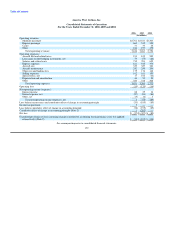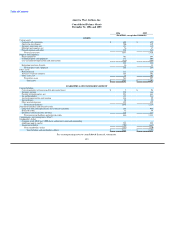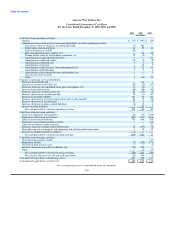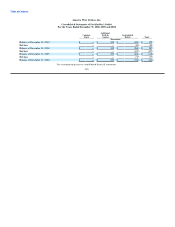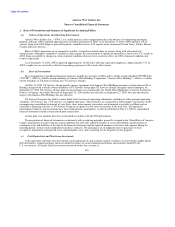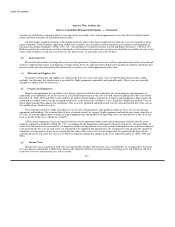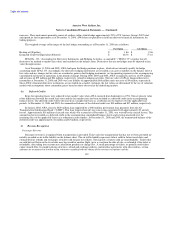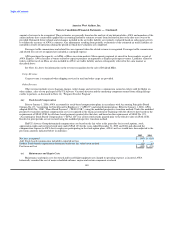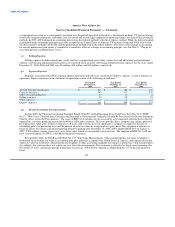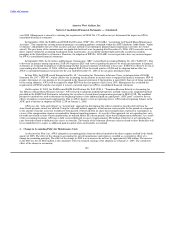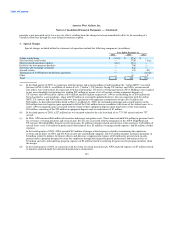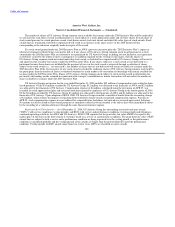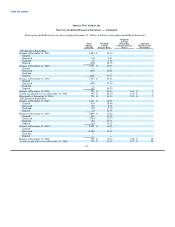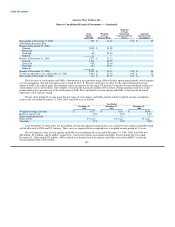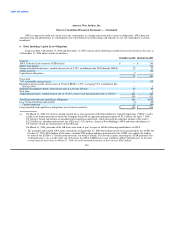US Airways 2006 Annual Report Download - page 145
Download and view the complete annual report
Please find page 145 of the 2006 US Airways annual report below. You can navigate through the pages in the report by either clicking on the pages listed below, or by using the keyword search tool below to find specific information within the annual report.
Table of Contents
America West Airlines, Inc.
Notes to Consolidated Financial Statements — (Continued)
year 2008. Management is currently evaluating the requirements of SFAS No. 157 and has not yet determined the impact on AWA's
consolidated financial statements.
In September, 2006, the FASB issued FASB Staff Position ("FSP") No. AUG AIR-1 "Accounting for Planned Major Maintenance
Activities". This amends the existing major maintenance accounting guidance contained within the AICPA Industry Audit Guide "Audits
of Airlines" and prohibits the use of the accrue in advance method of accounting for planned major maintenance activities for owned
aircraft. The provisions of the announcement are applicable for fiscal years beginning after December 15, 2006. AWA currently uses the
direct expense method of accounting for planned major maintenance, an acceptable method under generally accepted accounting
principles in the United States of America. Therefore, the adoption of FSP No. AUG AIR-1 is not expected to have any material impact
on AWA's consolidated financial statements.
In September 2006, the Securities and Exchange Commission ("SEC") issued Staff Accounting Bulletin No. 108 ("SAB 108"). Due
to diversity in practice among registrants, SAB 108 expresses SEC staff views regarding the process by which misstatements in financial
statements are evaluated for purposes of determining whether financial statement restatement is necessary. SAB 108 is effective for fiscal
years ending after November 15, 2006. AWA has adopted SAB 108 in the fourth quarter of 2006 and its adoption had no effect on
AWA's consolidated financial statements for the year ended December 31, 2006 or for any prior period presented.
In June 2006, the FASB issued Interpretation No. 48, "Accounting for Uncertainty in Income Taxes, an interpretation of FASB
Statement No. 109" ("FIN 48"), which clarifies the accounting for uncertainty in income taxes recognized in financial statements. FIN 48
requires the impact of a tax position to be recognized in the financial statements if that position is more likely than not of being sustained
by the taxing authority. AWA will be required to adopt FIN 48 in the first quarter of fiscal year 2007. Management has evaluated the
requirements of FIN 48 and does not expect it to have a material impact on AWA's consolidated financial statements.
On November 10, 2005, the FASB issued FASB Staff Position No. FAS 123R-3, "Transition Election Related to Accounting for
Tax Effects of Share-Based Payment Awards." AWA elected to adopt the modified prospective method, which is the simplified method
provided in the FASB Staff Position for calculating the tax effects of stock-based compensation pursuant to SFAS 123R. The modified
prospective method was used to determine the beginning balance of the additional paid-in capital pool ("APIC pool") related to the tax
effects of employee stock-based compensation. Due to AWA's history of tax net operating losses, AWA had no beginning balance in the
APIC pool at the date of adoption of SFAS 123R on January 1, 2006.
AWA uses the "with-and-without" or "incremental" approach for determining the order in which tax benefits derived from the
share-based payment awards are utilized. Using the with-and-without approach, actual income taxes payable for the period are compared
to the amount of income taxes that would have been payable if there had been no share-based compensation expense for tax purposes in
excess of the compensation expense recognized for financial reporting purposes. As a result of this approach, tax net operating loss carry
forwards not related to share-based compensation are utilized before the current period's share-based compensation deduction. As a result
of this accounting treatment, AWA has a fully reserved deferred tax asset of approximately $22 million related to tax net operating loss
carry forwards related to deductions for excess tax benefits. The benefit of the valuation allowance release related to these deductions will
be recorded directly to equity as additional paid-in-capital when such benefits are realized.
2. Change in Accounting Policy for Maintenance Costs
As discussed in Note 1(n), AWA changed its accounting policy from the deferral method to the direct expense method in the fourth
quarter of 2005. The effect of this change in accounting for aircraft maintenance and repairs is recorded as a cumulative effect of a
change in accounting principle. The effect of the change in 2005 was to increase the net loss by approximately $48 million. The increase
in the 2005 net loss of $202 million is the cumulative effect on retained earnings of the adoption as of January 1, 2005. The cumulative
effect of the change in accounting
142


